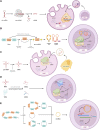The essential roles of small non-coding RNAs and RNA modifications in normal and malignant hematopoiesis
- PMID: 37065445
- PMCID: PMC10102602
- DOI: 10.3389/fmolb.2023.1176416
The essential roles of small non-coding RNAs and RNA modifications in normal and malignant hematopoiesis
Abstract
Hematopoietic stem cells (HSCs) developing from mesoderm during embryogenesis are important for the blood circulatory system and immune system. Many factors such as genetic factors, chemical exposure, physical radiation, and viral infection, can lead to the dysfunction of HSCs. Hematological malignancies (involving leukemia, lymphoma, and myeloma) were diagnosed in more than 1.3 million people globally in 2021, taking up 7% of total newly-diagnosed cancer patients. Although many treatments like chemotherapy, bone marrow transplantation, and stem cell transplantation have been applied in clinical therapeutics, the average 5-year survival rate for leukemia, lymphoma, and myeloma is about 65%, 72%, and 54% respectively. Small non-coding RNAs play key roles in a variety of biological processes, including cell division and proliferation, immunological response and cell death. With the development of technologies in high-throughput sequencing and bioinformatic analysis, there is emerging research about modifications on small non-coding RNAs, as well as their functions in hematopoiesis and related diseases. In this study, we summarize the updated information of small non-coding RNAs and RNA modifications in normal and malignant hematopoiesis, which sheds lights into the future application of HSCs into the treatment of blood diseases.
Keywords: RNA modification; epigenetic; hematological malignances; hematopoietic stem cell; small non-coding RNAs.
Copyright © 2023 Cai, Wang, Han, Huang and Qian.
Conflict of interest statement
The authors declare that the research was conducted in the absence of any commercial or financial relationships that could be construed as a potential conflict of interest.
Figures


Similar articles
-
Small noncoding RNAs play superior roles in maintaining hematopoietic stem cell homeostasis.Blood Sci. 2022 Jul 14;4(3):125-132. doi: 10.1097/BS9.0000000000000123. eCollection 2022 Jul. Blood Sci. 2022. PMID: 36518603 Free PMC article.
-
The regulation of normal and neoplastic hematopoiesis is dependent on microenvironmental cells.Adv Biol Regul. 2018 Aug;69:11-15. doi: 10.1016/j.jbior.2018.06.003. Epub 2018 Jun 27. Adv Biol Regul. 2018. PMID: 29970351 Free PMC article. Review.
-
The epitranscriptome of small non-coding RNAs.Noncoding RNA Res. 2021 Oct 26;6(4):167-173. doi: 10.1016/j.ncrna.2021.10.002. eCollection 2021 Dec. Noncoding RNA Res. 2021. PMID: 34820590 Free PMC article. Review.
-
Epigenetic regulation of hematopoietic stem cell homeostasis.Blood Sci. 2019 Sep 17;1(1):19-28. doi: 10.1097/BS9.0000000000000018. eCollection 2019 Aug. Blood Sci. 2019. PMID: 35402787 Free PMC article. Review.
-
The Role of N6-Methyladenosine (m6A) Methylation Modifications in Hematological Malignancies.Cancers (Basel). 2022 Jan 11;14(2):332. doi: 10.3390/cancers14020332. Cancers (Basel). 2022. PMID: 35053496 Free PMC article. Review.
References
Publication types
LinkOut - more resources
Full Text Sources

